Physical Address
304 North Cardinal St.
Dorchester Center, MA 02124
Although most primary pulmonary tumors are carcinomas, a large histologic spectrum of benign and malignant tumors of the lung exist. This chapter reviews the more common neoplasms according to the classification proposed by the World Health Organization (WHO) ( Box 37-1 ). Additionally, to address advances in oncology, molecular biology, pathology, radiology, and surgery this chapter includes the modifications in the histologic classification of lung cancer as proposed by Travis et al. This chapter also emphasizes the radiologic manifestations of thoracic neoplasms and the use of imaging in diagnosis and management.
Epithelial tumors
Benign
Papillomas
Adenomas
Malignant
Preinvasive lesions
Squamous carcinoma in situ
Atypical adenomatous hyperplasia
Adenocarcinoma in situ (formerly solitary bronchioloalveolar cell carcinoma [BAC])
Nonmucinous
Mucinous
Mixed mucinous/nonmucinous
Diffuse idiopathic pulmonary neuroendocrine cell hyperplasia
Squamous cell carcinoma
Variants: papillary, clear cell, small cell, basaloid
Adenocarcinoma
Minimally invasive adenocarcinoma (≤3 cm lepidic-predominant tumor with ≤ 5 mm invasion)
Nonmucinous
Mucinous
Mixed mucinous/nonmucinous mixed subtype
Invasive adenocarcinoma
Lepidic predominant (formerly nonmucinous BAC pattern with > 5-mm invasion)
Acinar predominant
Papillary predominant
Micropapillary predominant
Solid predominant with mucin production
Variants of invasive adenocarcinoma
Invasive mucinous adenocarcinoma (including formerly mucinous BAC)
Variants: fetal, colloid, enteric
Large cell carcinoma
Variants: large cell neuroendocrine, basaloid, lymphoepithelioma-like, clear cell, large cell with rhabdoid phenotype
Adenosquamous carcinoma
Small cell carcinoma
Variant: combined small cell carcinoma
Sarcomatoid carcinoma
Variants: pleomorphic, spindle cell, giant cell, carcinosarcoma, pulmonary blastoma (pleomorphic carcinoma, spindle cell carcinoma, giant cell carcinoma)
Carcinoid tumor
Typical carcinoid
Atypical carcinoid
Salivary gland tumors
Mucoepidermoid carcinoma
Adenoid cystic carcinoma
Diffuse idiopathic pulmonary neuroendocrine cell hyperplasia
Mesenchymal tumors
Epithelioid hemangioendothelioma
Angiosarcoma
Pleuropulmonary blastoma
Chondroma
Congenital peribronchial myofibroblastic tumor
Diffuse pulmonary lymphangiomatosis
Inflammatory myofibroblastic tumor
Lymphangioleiomyomatosis
Synovial sarcoma
Pulmonary artery/vein sarcoma
Lymphoproliferative tumors
Marginal zone B-cell lymphoma of the mucosa-associated lymphoid tissue (MALT)
Diffuse large B-cell lymphoma
Lymphomatoid granulomatosis
Langerhans cell histiocytosis
Miscellaneous tumors
Hamartoma
Sclerosing hemangioma
Clear cell tumor
Germ cell tumor
Atypical adenomatous hyperplasia (AAH), a localized proliferation of atypical type II pneumocytes and/or Clara cells lining alveoli and respiratory bronchioles, is typically less than 5 mm in diameter. AAH is considered a precursor of adenocarcinoma, based on a variety of molecular findings that demonstrate a relationship to lung adenocarcinoma, including clonality, KRAS mutation, EGFR mutation, p53 expression, loss of heterozygosity, methylation, and epigenetic alterations in the Wnt pathway. The frequency of AAH is unknown but has been reported as an incidental finding in 2% to 3% of patients without a primary lung cancer at postmortem examination. However, AAH is most frequently diagnosed in patients with primary non–small cell carcinoma, especially adenocarcinoma. In this regard, AAH occurs in the adjacent lung parenchyma in 5% to 23% of resected lung adenocarcinomas. It has also been reported that AAH lesions are not significantly correlated with gender, age, smoking status, familial history of malignancy, or preceding malignancy.
Radiologically, AAH manifests as a small well-circumscribed solitary or multifocal ground-glass nodular opacity—usually less than 1 cm but ranging in size from a few millimeters to approximately 2 cm—that typically remains stable for several months to years. Because AAH and adenocarcinoma can have similar radiologic manifestations, computed tomography (CT) differentiation is often difficult, and resection is usually required for a definitive diagnosis.
A major change in the classification proposal for lung adenocarcinoma by Travis et al. is the recognition of adenoma in situ (AIS) as a preinvasive lesion. AIS was formerly classified as a bronchioloalveolar cell carcinoma (BAC) according to the 2004 WHO classification. AIS is a small (≤3 cm) localized adenocarcinoma that has no stromal, vascular, or pleural invasion and demonstrates lepidic growth. Most AISs are nonmucinous and consist of type II pneumocytes and/or Clara cells with no nuclear atypia. The rare cases of mucinous AIS consist of tall columnar cells with basal nuclei and abundant cytoplasmic mucin.
Radiologically, nonmucinous AIS typically manifests on CT as a pure ground-glass nodule (GGN) but can occasionally manifest as a part solid (due to focal collapsed alveoli or focal thickened alveolar septa) or solid nodule. Mucinous AIS can manifest as a solid nodule or consolidation.
Diffuse idiopathic pulmonary neuroendocrine cell hyperplasia (DIPNECH) is a widespread proliferation of pulmonary neuroendocrine cells or neuroendocrine bodies within the epithelium of the distal bronchi or terminal bronchioles. DIPNECH is regarded as a precursor lesion of neuroendocrine lung tumors, specifically carcinoid tumors. This proliferation is uncommon and can be confined to the bronchial and bronchiolar epithelium, or there can be extension beyond the basement membrane, forming small localized or diffuse aggregates called tumorlets (<0.5 cm in diameter) or carcinoids (>0.5 cm). An important histologic feature occurring in a third of patients is fibrous obliterative bronchiolitis and peribronchiolar fibrosis of the involved airways.
DIPNECH occurs more frequently in women, and most patients present in their fifth or sixth decades (mean age, 58 years), although the age of distribution is wide (22-79 years). Patients with DIPNECH typically have a chronic history of an insidious onset of progressive dyspnea and nonproductive cough. Radiologically, DIPNECH manifests as bronchial wall thickening and a mosaic attenuation pattern (ground-glass opacities and hyperlucent areas) due to air trapping. Solitary or multiple nodules ranging in size from 2 to 20 mm in diameter are an associated feature ( Fig. 37-1 ).
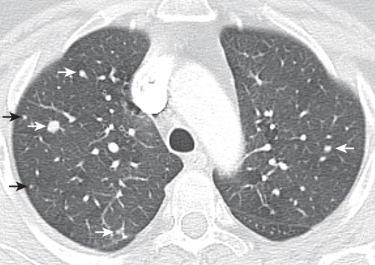
Lung cancer is a common malignancy. The American Cancer Society (ACS) estimates that 224,210 new cases will be diagnosed in the United States in 2014. Lung cancer incidence rates have declined since the mid-1980s in men and late 1990s in women as a result of reduced smoking prevalence. The number of new cases in men has been decreasing at 1.9% per year (1992-2010) and at 1.2% (2005-2010) in woman. The annual mortality rate in men has decreased since the 1990s, and in 2005-2010 this decrease was 2.9% per year, whereas the rate in women, after continuously increasing for several decades, plateaued in 2004 and is now decreasing by 1.4% per year (2004-2010). However, lung cancer remains the leading cause of cancer-related deaths in both men and women in the United States, and the ACS estimates that in 2014 it will account for 28% (86,930) of all cancer deaths in men and 26% (72,330) in women.
The carcinogenic effect of tobacco smoke was established in 1950 when Doll and Hill conducted the first large epidemiologic study. Cigarette smoking is now recognized as the strongest risk factor for the development of lung cancer; an estimated 85% to 90% of lung cancers in men and 80% in women are attributable to smoking. The risk increases with early age at initiation and the length of time and number and type of cigarettes smoked. Nearly all cases of squamous cell and small cell carcinoma are related to cigarette smoking. Although squamous cell and small cell lung carcinomas have been considered to have the highest association with smoking, it has recently been reported that adenocarcinomas are more strongly associated with tobacco smoke exposure than previously recognized. The change in smoking habits (use of filter tips, decrease in tar yield) has been postulated to account for the increase in incidence of adenocarcinomas in cigarette smokers. Additionally, because adenocarcinomas are more likely to be caused by other factors besides smoking (e.g., passive smoke inhalation), adenocarcinomas are the predominant cell type in nonsmokers.
Involuntary smoke exposure (passive smoking) has been reported to increase cotinine, the main metabolite of nicotine, and is generally considered to be associated with an increased risk of lung cancer. According to the International Agency for Research on Cancer, involuntary smoking causes lung cancer in never-smokers, with an excess risk of 20% for women and 30% for men. In the workplace, involuntary smoke exposure is reported to be associated with an increase of 16% to 19% in the risk of lung cancer among never-smokers. This conclusion is supported by a meta-analysis comprising 22 studies that showed a 24% increase in lung cancer risk among workers exposed to environmental tobacco smoke.
Environmental and occupational exposures to particulate and chemical substances are additional risk factors. Exposure to the naturally occurring radioactive gas radon, both in homes and in mines, is an important risk factor for lung cancer. In fact radon is the second leading cause of lung cancer death among smokers and nonsmokers. It is estimated that 7000 to 30,000 lung cancer deaths occur annually in the United States as a result of residential exposure to radon. Additional risk factors for development of lung cancer include exposure to arsenic, chloromethyl ethers, chromium, isopropyl oil, mustard gas, nickel, chloroprene, vinyl chloride, and various smelting byproducts such as lead and copper. Although exposure to beryllium has been reported to cause an increased risk for lung cancer on the order of 20% or higher, a recent study indicates a lack of increased lung cancer risk among workers employed in the modern beryllium industry with exposure restricted to insoluble beryllium. Asbestos is also a carcinogen, and although there is an unequivocal association between lung cancer and asbestos exposure, the magnitude of the risk is frequently overestimated (most cohort studies show less than a twofold increase in risk). Although the risk of lung cancer in workers exposed to asbestos may depend on individual occupational exposure characteristics (e.g., duration, concentration, fiber type), the increased risk may be largely limited to those with radiologic evidence of asbestosis or to cigarette smokers. It has been estimated that as many as 33% of lung cancers that occur in smokers exposed to asbestos are the result of the synergistic effect of the two carcinogens.
Other factors such as focal or diffuse pulmonary fibrosis and ionizing radiation have been reported to increase the risk of lung cancer. However, epidemiologic data do not clearly establish a cause-and-effect relationship except in some patients with Hodgkin's disease treated with radiation. Finally, although not clearly understood, it is likely that genetic susceptibility to lung cancer may be important independent of smoking history or exposure to environmental cigarette smoke. A number of different gene mutations (e.g., p53, KRAS ) are common in lung cancer, and there is a strong association between KRAS mutations in adenocarcinoma and smoking. In addition, mutations of the epidermal growth factor receptor gene (EGFR) appears to have a strong association with adenocarcinoma and effectiveness of therapy. Additionally, although multigenic factors that influence carcinogen metabolism seem likely to play a role, it appears that a region on chromosome 6q may be important in familial lung cancer, and there is compelling evidence that a locus at 15q25 predisposes to lung cancer.
Lung cancer is divided by the 2004 WHO Classification into two major histologic categories: non–small cell lung carcinoma (NSCLC) and small cell lung carcinoma (SCLC) (see Box 37-1 ). NSCLC is further subdivided into histologic types such as squamous cell carcinoma, adenocarcinoma, and large cell carcinoma according to the most differentiated portion of the tumor. However, many tumors are composed of more than one histologic type; a definitive diagnosis may require a resected specimen. NSCLCs are also graded as well differentiated, moderately differentiated, or poorly differentiated according to the least differentiated feature. Additionally, some NSCLCs have immunohistochemical and/or ultrastructural features of neuroendocrine differentiation and are collectively referred to NSCLCs with neuroendocrine differentiation.
Squamous cell carcinomas have been decreasing in relative incidence and now constitute approximately 30% of all lung cancers Histologically, squamous cell carcinoma grows in nests within a desmoplastic stroma, and the tumor cells demonstrate keratinization, intercellular bridge formation, and squamous pearls. They typically occur in central bronchi and frequently manifest as postobstructive pneumonia or atelectasis ( Fig. 37-2 ). Mucoid impaction, bronchiectasis, and hyperinflation are uncommon radiologic manifestations. Approximately one third of squamous cell carcinomas occur beyond the segmental bronchi and usually range in size from 1 to 10 cm ( Fig. 37-3 ). Squamous cell carcinomas are more likely to cavitate than the other histologic cell types of lung cancer. Cavitation occurs in 10% to 30% and is more common in large peripheral masses and poorly differentiated tumors. Cavitation is typically eccentric with thick irregular walls, although thin walls may occur in rare circumstances. Most squamous cell carcinomas grow slowly, and extrathoracic metastases tend to occur late.
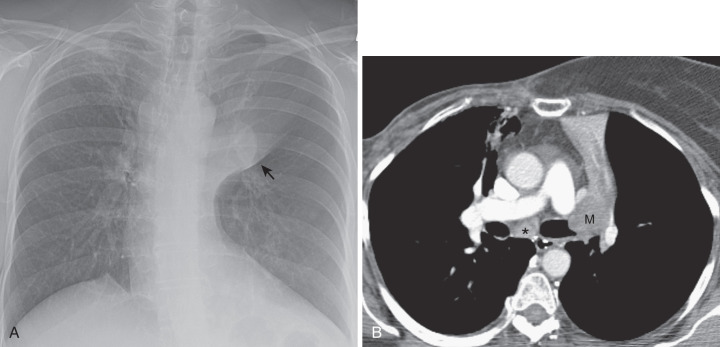
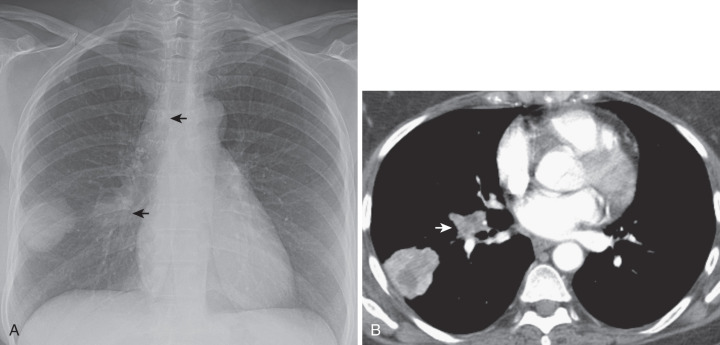
The increasing incidence of adenocarcinoma since the 1970s has resulted in a notable shift in the incidence rates of lung cancer according to histologic type. Although the rate of increase in the incidence of adenocarcinomas has slowed in the United States since 1999, adenocarcinoma has replaced squamous cell carcinoma as the most frequent histologic form of lung cancer and is now the most common cell type (≈50% of all lung cancers).
Significant changes in pathologic classification of lung adenocarcinoma were proposed in 2011 as a result of the recommendations of an international multidisciplinary core panel of experts sponsored by the International Association for the Study of Lung Cancer (IASLC), American Thoracic Society, and European Respiratory Society. The proposed changes in classification address advances in oncology, molecular biology, pathology, radiology, and surgery and, by improving the diagnosis and classification of lung adenocarcinoma, should result in improved therapeutic outcomes. This new adenocarcinoma classification is primarily based on histology and provides uniform terminology and criteria that define pathologic entities, as well as information relevant to patient management. Unlike previous WHO classifications where the primary diagnostic criteria were based on hematoxylin and eosin examination, this classification emphasizes the use and integration of immunohistochemical (i.e., thyroid transcription factor, p63 staining), histochemical (i.e., mucin staining), and molecular studies.
The new adenocarcinoma classification taxonomy now includes the term minimally invasive adenocarcinoma. Minimally invasive adenocarcinoma (MIA) is a solitary adenocarcinoma (≤3 cm) with 5-mm or less invasion in any one focus and a predominantly lepidic pattern of growth. MIA is usually nonmucinous but rarely can be mucinous. The invasive component can be acinar, papillary, micropapillary, and/or solid. MIA is excluded if the tumor invades lymphatics, blood vessels, or pleura or contains necrosis. Accordingly the diagnosis of MIA requires entire histologic sampling of the tumor. Invasive adenocarcinomas are composed of a complex heterogeneous mixture of histologic subtypes, and the proposed classification by Travis et al. classifies lung adenocarcinomas according to the most predominant subtype. The most predominant histologic subtype (e.g., lepidic, acinar, papillary, micropapillary, or solid) is now added as a descriptor to invasive adenocarcinoma; this replaces use of the term adenocarcinoma, mixed subtype. For example, lepidic-predominant adenocarcinoma (LPA), consisting of bland pneumocytic cells (type II pneumocytes or Clara cells) growing along the surface of alveolar walls, is a nonmucinous adenocarcinoma that can have necrosis, invasion of lymphatics or blood vessels, and at least one focus of invasion larger than 5 mm. Acinar-predominant adenocarcinoma shows a majority component of glands with a central luminal space surrounded by tumor cells. Papillary-predominant adenocarcinoma shows a major component of a growth of glandular cells along central fibrovascular cores, and micropapillary-predominant adenocarcinoma has tumor cells growing in papillary tufts that lack fibrovascular cores. Solid-predominant adenocarcinoma has a major component of polygonal tumor cells forming sheets that lack recognizable patterns of acinar, papillary, micropapillary, or lepidic growth.
For mucinous malignancies the term invasive mucinous adenocarcinoma has replaced “mucinous BAC.” Invasive mucinous adenocarcinoma has a distinctive histologic appearance, with tumor cells having a goblet or columnar cell morphology with abundant intracytoplasmic mucin. These tumors can show the same heterogeneous mixture of lepidic, acinar, papillary, micropapillary, and solid growth as nonmucinous tumors. However, these tumors differ from mucinous AIS and MIA by being larger than 3 cm and/or showing invasion greater than 0.5 cm and/or multiple nodules, or lack of a circumscribed border with miliary spread into adjacent lung parenchyma. Invasive mucinous adenocarcinoma typically manifests as solid nodules or consolidative opacities.
Adenocarcinomas typically manifest radiologically as peripheral solitary pulmonary nodules. Historically, nodules have been described as having soft tissue attenuation and an irregular or spiculated margin as a result of parenchymal invasion and an associated fibrotic response ( Fig. 37-4 ). However, with the increasing use of CT and recent interest in screening for lung cancer, adenocarcinomas manifesting as purely ground-glass or part-solid attenuation are being detected with increasing frequency ( Fig. 37-5 ). In this regard nonmucinous minimally invasive and lepidic-predominant adenocarcinomas typically manifest as solitary GGNs or part-solid nodules (PSNs). Acinar-, papillary-, micropapillary-, or solid-predominant patterns and invasive mucinous adenocarcinomas manifest as solid nodules, although invasive mucinous adenocarcinomas can also be consolidative opacities and are frequently multifocal ( Figs. 37-6, 37-7, and 37-8 ).
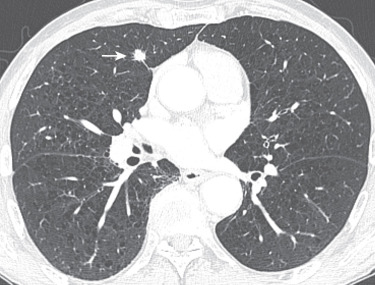
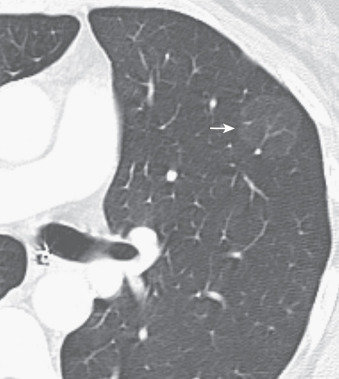
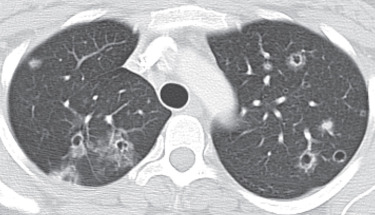
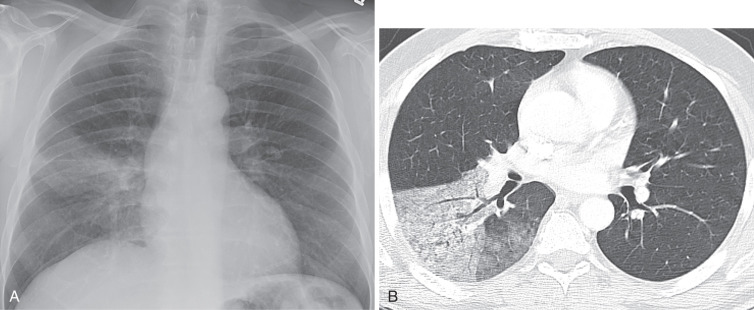
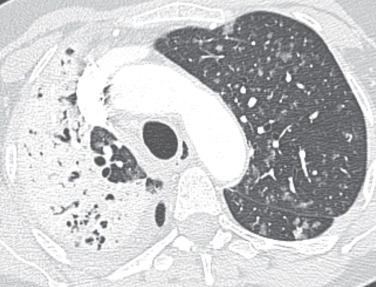
To date there has not been a large series validating the radiologic-pathologic correlation of the proposed classification as it pertains to the size of the invasive histologic component and solid component detected on CT in MIA and LPA. However, Suzuki et al. characterized the presence and distribution of soft tissue within 349 stage I adenocarcinomas that were 2 cm or less in size. The tumors ranged from pure GGNs to PSNs on CT. A direct correlation was reported between the presence and size of the solid component of PSNs with the degree of invasion of adenocarcinomas. Additionally, the high-resolution (HR)CT appearance of these opacities has been reported to have a correlation with a classification proposed by Noguchi et al., whereby small (≤2 cm) peripheral adenocarcinomas are classified into six types based on tumor growth patterns: type A, localized BAC; type B, localized BAC with foci of structural collapse of alveoli; type C, localized BAC with active fibroblastic proliferation; type D, poorly differentiated adenocarcinoma; type E, tubular adenocarcinoma; and type F, papillary adenocarcinoma with a compressive growth pattern. Ground-glass attenuation of nodular opacities has been reported to be more frequent in types A to C than types D to F, whereas soft tissue attenuation is more frequent in types B to F. The soft tissue attenuation component tends to be absent or less than a third of the opacity with type A and greater in extent (more than two thirds) in types D to F. Additionally the likelihood of invasive adenocarcinoma and more advanced stage of lung cancer has been reported to be more likely with mixed and solid opacities.
Lymphangitic carcinomatosis, although uncommon at presentation, occurs more frequently with adenocarcinomas and typically manifests radiologically as thickening of interlobular septa or multiple small pulmonary nodules ( Fig. 37-9 ). Intrathoracic metastases to hilar and mediastinal nodes are present in 18% to 40% and in 2% to 27% of patients, respectively, and tend to occur more often with more centrally located adenocarcinomas.

These lesions make up 10% to 20% of all lung cancers and include the variant large cell neuroendocrine lung carcinoma (3% of lung cancers in surgical series). Most are peripheral, poorly marginated masses greater than 7 cm in diameter ( Fig. 37-10 ). Although growth is typically rapid, cavitation is uncommon. Hilar and mediastinal adenopathy occurs in up to one third of patients at presentation, and early extrathoracic metastases are common.
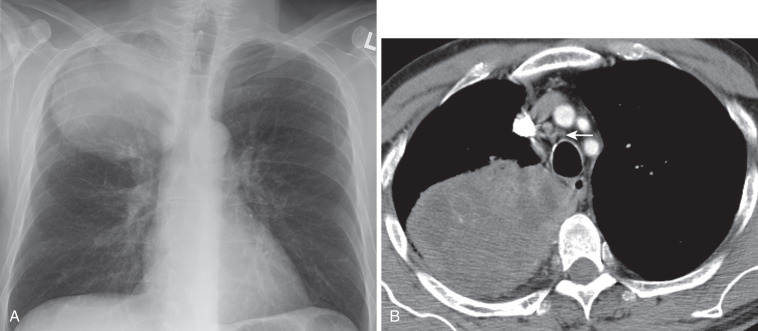
SCLCs comprise 13% to 15% of all lung cancers and have been decreasing in incidence in the United States over the last few decades. SCLC is characterized histologically by small cells with scant cytoplasm, marked nuclear atypia, high mitotic rate (>10 mitoses/10 high-power field [HPF]) and extensive necrosis. There are two subtypes: pure SCLC (≈70%) and combined SCLC (≈30%). Immunohistochemical stains including chromogranin and synaptophysin, CD56, TTF-1, and Ki-67, together with pancytokeratin antibodies, are used to differentiate SCLC from other lung neoplasms. The Ki-67 proliferation index is typically high (80%-100%) and is useful in separating SCLC from carcinoid tumors.
The primary tumor is typically small, central in location, and associated with marked hilar and mediastinal adenopathy and distant metastases to liver, bone marrow, adrenals, and brain ( Fig. 37-11 ). Pleural effusions occur in 5% to 40% of patients. Approximately 5% of SCLCs manifest as small, peripheral, solitary pulmonary nodules without intrathoracic adenopathy, disseminated extrathoracic disease, or pleural effusions.
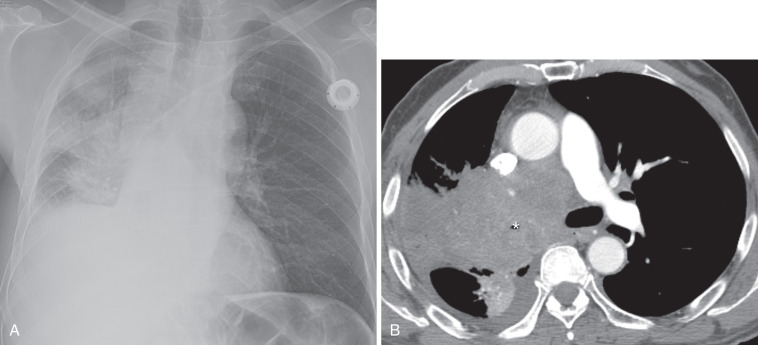
Most patients are in their fifth and sixth decades of life, and approximately three quarters of patients are symptomatic at presentation. Symptoms are variable and depend on the local effects of the primary mass, presence of regional or distant metastases, and coexistence of paraneoplastic syndromes.
Although solitary peripherally located tumors tend to be asymptomatic, central endobronchial carcinomas can manifest with fever, dyspnea, hemoptysis, and cough. Of these, cough is the most common presentation and may result from endobronchial irritation, parenchymal infiltration, or postobstructive pneumonia. Cough productive of copious amounts of watery sputum (bronchorrhea) typically also occurs in patients with invasive mucinous adenocarcinoma and extensive parenchymal disease, but this is rarely seen. Symptoms that can result from local growth and invasion of adjacent nerves, vessels, and mediastinal structures include:
Chest pain (peribronchial nerve involvement), vocal cord paralysis, and hoarseness (recurrent laryngeal nerve involvement) ( Fig. 37-12 ). Recurrent laryngeal nerve paralysis more commonly involves the left vocal cord because the right-side recurrent laryngeal nerve does not traverse extensively into the chest. Other symptoms are dyspnea due to diaphragmatic paralysis (phrenic nerve involvement) (see Fig. 37-12 ) and Horner's syndrome (ptosis [narrowing of the palpebral fissure], miosis [pupillary constriction], anhidrosis [absence of sweating on one side of the face]) due to sympathetic chain and stellate ganglion involvement by superior sulcus tumors ( Fig. 37-13 ). Non–small cell carcinomas of the superior pulmonary sulcus represent 3% of all lung cancers and can also manifest as arm pain and atrophy of the intrinsic muscles of the hand.
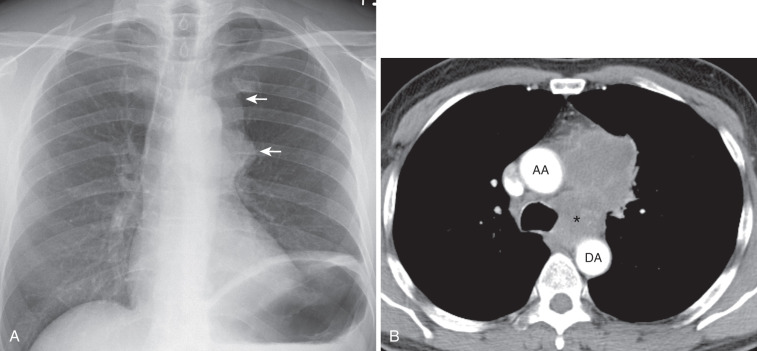
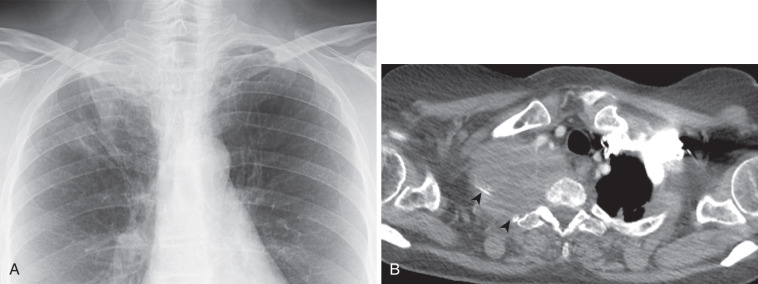
Facial and upper truncal edema, headaches, neck vein distention, and enlarged collateral chest wall vessels (superior vena cava obstruction). The clinical manifestations vary with the rapidity with which obstruction of the superior cava develops and the location of the occlusion (i.e., occlusion proximal to the juncture of the azygous vein and superior vena cava is associated with more marked clinical manifestations).
Dysphagia (esophageal involvement). Esophageal involvement is usually due to extrinsic compression by the tumor or associated mediastinal lymphadenopathy. Formation of a tracheo- or bronchoesophageal fistula is uncommon (frequency of 0.16%) and manifests as cough and recurrent aspiration pneumonia.
Many patients present with nonspecific systemic manifestations of malignancy, including anorexia, weight loss, or fatigue. Additionally the symptoms can be related to the site of metastatic disease, with bone pain and symptoms of brain metastases (e.g., headache, nausea, vomiting, seizures, mental status changes) being most common. Clinical signs and symptoms can also be caused by tumor excretion of a bioactive substance or hormone, or as a result of immune-mediated neural tissue destruction caused by antibody- or cell-mediated immune responses. These paraneoplastic syndromes occur in 10% to 20% of lung cancer patients and are usually associated with SCLC. Antidiuretic and adrenocorticotropin hormones are the more frequently excreted hormones and can result in hyponatremia and serum hypoosmolarity and in Cushing's syndrome (central obesity, hypertension, glucose intolerance, plethora, hirsutism), respectively. Other hormones that can be elevated are calcitonin, growth hormone, human chorionic gonadotropin, and (rarely) prolactin and serotonin. Neurologic paraneoplastic syndromes (Lambert-Eaton myasthenic syndrome—clinically characterized by craniocaudally progressive proximal muscle weakness that occurs predominantly at the hip girdle; anti-Hu syndrome—limbic encephalitis, brainstem encephalitis, cerebellar degeneration, opsoclonus myoclonus, myelopathy, cranial nerve palsy, sensory neuropathy; and anti-Yo syndrome—primarily brainstem abnormalities and paraneoplastic cerebellar degeneration) are rare and usually associated with SCLC. The neurologic symptoms typically precede the diagnosis of lung cancer by up to 2 years, are incapacitating, and progress rapidly, although improvement can occur after treatment of the lung cancer.
Miscellaneous paraneoplastic syndromes associated with lung cancer include acanthosis nigricans, dermatomyositis, disseminated intravascular coagulation, and hypertrophic pulmonary osteoarthropathy (HPO). Of these, HPO is the most common, occurring in up to 17% of patients with adenocarcinoma ( Fig. 37-14 ).
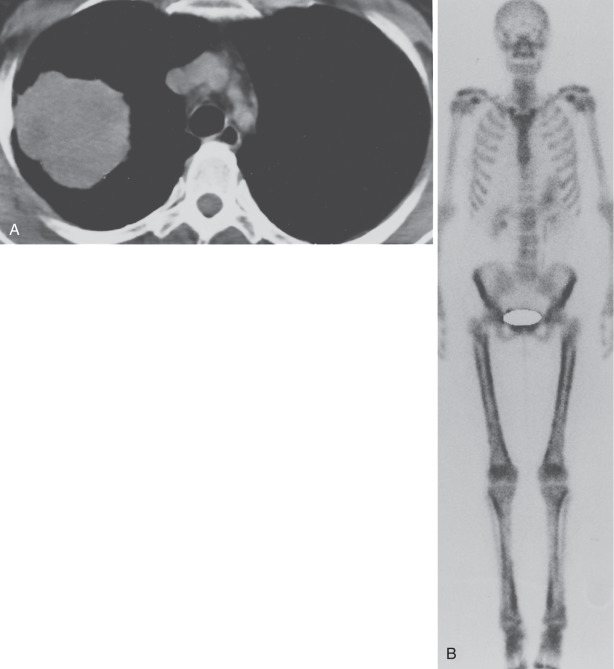
Imaging has an important role in screening for malignancy as well as in diagnosis, staging, and monitoring of patients with lung cancer.
Because diagnosis of lung cancer at an early stage is associated with an improved prognosis, screening has been advocated to detect lung cancer before clinical presentation. During the 1990s, multiinstitutional single-arm low-dose CT screening studies in the United States, as well as other small trials in Japan and Germany, were performed to examine the role of screening in lung cancer management and showed higher-than-expected lung cancer detection at early stages. Following these results, an international single-arm study was initiated, the International Early Lung Cancer Action Program, and reported a high percentage of clinical stage I lung cancer detected at baseline and annual screening. However, to overcome the various biases inherent in the results of single-arm trials, randomized controlled trials have been conducted. The National Lung Screening Trial (NLST), a randomized study comparing the effectiveness of low-dose CT (LDCT) to chest radiography in more than 50,000 participants, reported significant reductions in lung cancer (20%) and all-cause mortality (6.7%). Accordingly, LDCT is currently advocated as a screening tool for lung cancer. However, optimal screening strategies have not been determined. In this regard, it is uncertain whether younger patients and/or smokers with less pack-years' smoking history than the eligibility criteria used for those examined in the NLST (55- to 74-year-old patients with at least 30 pack-years' smoking history who were still active smokers, or former smokers who stopped smoking within the previous 15 years) will also benefit from screening. It is hoped that contentious issues including overdiagnosis bias, whether detection of preclinical disease affects survival, and the cost-effectiveness of screening programs will be resolved in the coming years.
Because most patients with lung cancer have advanced disease at presentation, diagnosis is usually not difficult. Nevertheless, 20% to 30% of patients with lung cancer present with a solitary pulmonary nodule that may be difficult to differentiate from a benign nodule. Certain morphologic and physiologic features, however, may suggest a diagnosis of lung cancer:
Size. The larger the nodule, the more likely it is to be malignant. Small size, however, cannot be used to reliably exclude lung cancer, since many resected lung cancers are less than 2 cm in diameter. Additionally the widespread use and improvements in CT technology, coupled with a recent interest in CT screening for lung cancer, has resulted in frequent and incidental detection of small nodules (1-5 mm). Although the majority of these nodules are benign, studies of resected small nodules have shown that a considerable number are either primary or secondary pulmonary malignancies.
Margins . Lung cancers typically have irregular or spiculated margins. Although suggestive of lung cancer, these findings can occasionally be seen with benign nodules. Furthermore, a smooth margin, a feature typical of benign nodules, cannot be used to exclude lung cancer, because 20% of malignant nodules have this appearance.
Internal morphology . Except for fat (attenuation −40 to −120 Hounsfield units [HU]) and calcification within a nodule, internal morphology is unreliable in distinguishing lung cancer from a benign nodule. Calcification occurs histologically in up to 14% of lung cancers and may be detected by CT. It is typically amorphous in appearance ( Fig. 37-15 ), unlike the diffuse solid, central punctate, or laminated calcifications that are diagnostic of benign nodules. Amorphous calcification, however, is not diagnostic of lung cancer, because similar calcifications are occasionally detected in benign lesions. Widespread use of thin collimation CT images has increased the detection of soft tissue nodules with low attenuation (GGNs, PSNs) ( Fig. 37-16 ). Henschke et al. have reported that part-solid nodular opacities have the highest incidence of malignancy (63%) as opposed to 18% for ground-glass opacities and 7% malignancy rate for solid nodules. Importantly, with these nodules the likelihood of malignancy varies according to the degree of soft tissue attenuation. However, the soft tissue component of PSNs can represent the invasive component and/or fibrosis and alveolar collapse. The degree of invasion is reported to correlate directly with the size of the soft tissue component on CT. To improve characterization of the degree of invasion of part-solid adenocarcinomas, Yamada et al. measured CT attenuation numbers of the solid part of PSNs and reported that CT attenuation number was significantly higher in the group with invasion compared to the no-invasion and microinvasion groups. In addition the presence of notches in the nodule margin and pleural tags are more frequent in invasive adenocarcinoma as compared to MIA and AIS. The frequency of lobulation, spiculation, well-defined but coarse interface, and pseudocavitation (small focal lucencies) have also been reported to be significantly higher in malignant PSNs than benign nodules. However, there is considerable overlap, and infectious and inflammatory etiologies can also manifest as pseudocavitation. Cavitation occurs in benign nodules and lung cancer. Malignant nodules typically have thick irregular walls, whereas benign nodules have smooth thin walls. These findings, however, are not specific, and wall thickness cannot be used to confidently differentiate benign nodules from lung cancer.
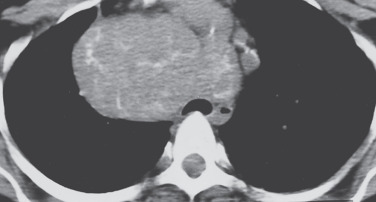
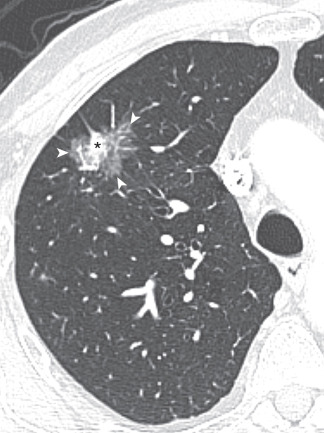
Growth . Based on radiographic analysis, lung cancers typically double in volume (an increase of 26% in diameter) between 30 and 400 days (average, 240 days). However, it is difficult to reliably detect growth in small nodules, because the small change in diameter associated with a doubling of volume may not be visible on radiographs. The use of CT can improve the accuracy of growth assessment, and growth can be detected in lung cancers as small as 5 mm when CT imaging is repeated within 30 days. In a screening study analyzing the growth rates of small lung cancers using CT, Hasegawa et al. reported that doubling in volume ranged from 52 to 1733 days (mean, 452 days), and approximately 20% (12 of 61) of these opacities had a volumetric doubling time greater than 2 years. These nodular opacities were typically well-differentiated adenocarcinomas. In this regard, the use of stability in size for 2 years to infer benignity has been questioned by Yankelevitz et al., and it is recommended that this criterion be used with caution. In addition, when determining growth of a PSN, the limitations in assessing growth are compounded because these lesions are typically small, poorly defined, and growth can be indolent and difficult to perceive. Also, in contrast to growth in solid nodules based only on size, growth of PSNs can manifest as increase in size and/or increase in attenuation and/or development or increase in size of a solid component. These imaging features of growth are suspicious for increased risk of malignancy. It is important to emphasize that in the serial evaluation of GGNs or PSNs to determine growth, 37% to 70% of screen-detected nodules resolve on follow-up imaging.
Measurement of serial volumes rather than diameters, and computer-calculated doubling of volume of small nodules have been suggested to be an accurate and potentially useful method to assess growth. In a study by Jennings et al. analyzing the growth rates of stage I lung cancers with serial volumetric CT measurements, the median time to double in volume was 207 days (50% of the tumors doubled in volume at 8 weeks and 75% at 14 weeks). However, there was a wide variability in growth rates, and 21 of 149 tumors did not increase or decreased in volume between examinations, and two tumors doubled in volume after 24 months. Recently nodule mass, defined as the combination of nodule volume and density, has been proposed as a more accurate determination of growth of PSNs. By multiplying nodule volume and density, mass measurements allow detection of growth of PSNs earlier and are subject to less variability than volume or diameter measurements. At present the determination of when and how to observe and image small nodules in the assessment of tumor growth rate has not been resolved. However, the Fleischner Society has guidelines for evaluation of an incidentally discovered solid nodule in an adult patient that integrate lesion morphology, growth rate, patient age, and smoking history ( Box 37-2 ). In addition, to complement the recommendations for incidentally detected solid nodules, the Society has recently published recommendations specifically aimed at the management of GGNs and PSNs ( Box 37-3 ). Importantly for GGNs and PSNs, risk factors such as smoking history, familial history of lung cancer, or exposure to carcinogenic agents are not considered in the current guidelines owing to a lack of sufficient data. In addition, other issues to be aware of are that a slight temporary decrease in size can be seen, with adenocarcinomas manifesting as GGNs or PSNs owing to fibrosis or atelectasis; enlargement and/or increasing attenuation with or without the new appearance of a solid component during follow-up should be managed with a high degree of suspicion.
Become a Clinical Tree membership for Full access and enjoy Unlimited articles
If you are a member. Log in here